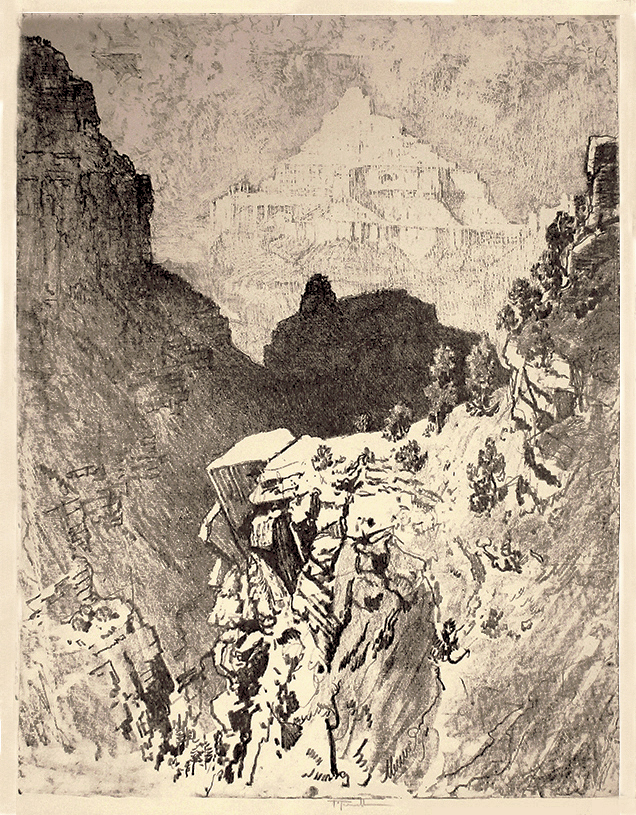The Temple is a lithograph created in 1912 by American artist Joseph Pennell. It is pencil signed by the artist in the lower center margin. The references are Wuerth 259 and Library of Congress 1614. Wuerth lists the edition at twenty-five impressions. The Temple was printed by the Ketterlinus Lithographic Company in Philadelphia on cream, laid MBM (FRANCE) watermarked paper. The image measures 22-1/8 x 16-7/8 inches. The Temple is gallery inventory number 20749.
The Temple is the sixth of eleven large lithographs from the series The Grand Canyon of the Colorado, Arizona. In this lithograph, Pennell captured the spectacular Vishnu Temple which rises to an elevation of 7,533 feet. In the foreground are the Krishna and Rama shrines. While surveying the Grand Canyon in 1880, Major Clarence Dutton was tremendously impressed by the majestic peaks rising above the riverbed. They reminded him of Hindu temples and so he named the massive pyramid shaped peak Vishnu Temple.
The Grand Canyon is one of the seven natural wonders of the world and over the years twenty-three peaks have been officially designated as temples. These include Vishnu Temple, Brahma Temple, Buddha Temple, Solomon’s Temple, Deva Temple, Zoroaster Temple, Isis Temple, Shiva Temple, Juno Temple, Jupiter Temple, and Vesta Temple, to name a few.
Joseph Pennell was born on 4 July 1857 to Quaker parents in Philadelphia. He studied at the Pennsylvania Academy of Fine Arts and the Pennsylvania School of Industrial Art. Considered by many to be the dean of American printmaking, Pennell was a lithographer, etcher, author, educator, lecturer, and illustrator.
By 1882, Pennell was illustrating for Scribner's Magazine and The Century and received a commission for illustrating a book on Tuscany. In 1884 he traveled to Europe and settled in London where he produced numerous books, both as an author and as an illustrator, many of them in collaboration with his wife, author Elizabeth Robins Pennell. In 1912, Pennell left London for Panama where he created a series of lithographs rendering the construction of the Panama Canal. He voyaged via steamer along the Pacific Coast to San Francisco where he created numerous etchings of the city by the bay and, while there, influenced the founding of the California Society of Etchers.
In 1915, Pennell chaired the jury for etchings and engravings for the Panama-Pacific International Exposition where over 2,200 prints were exhibited and an entire gallery was devoted to his work. Pennell was a member of numerous organizations, including the Society of Painter-Etchers in London and was first president of the Senefelder Club. His tutelage of artists and scholars continue with his books Etchers and Etching and Lithography and Lithographers, and the bequest of his collection of prints and drawings to the Library of Congress. Pennell produced more than 900 etchings and mezzotints and more than 600 lithographs on architectural and landscape subjects. He distinguished himself as one of America’s most talented etchers as well as a promotional genius who helped spur the revival of printmaking and print collecting during the first two decades of the 20th century.
Joseph Pennell died in Brooklyn Heights, New
York on April 23, 1926.



